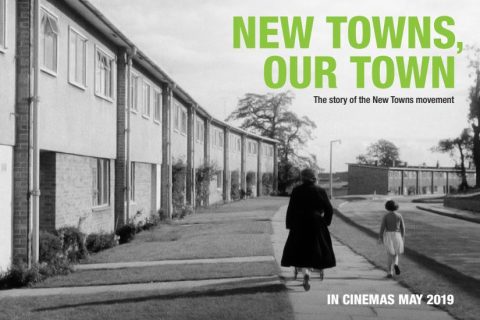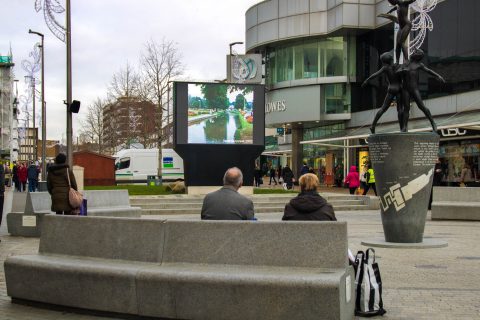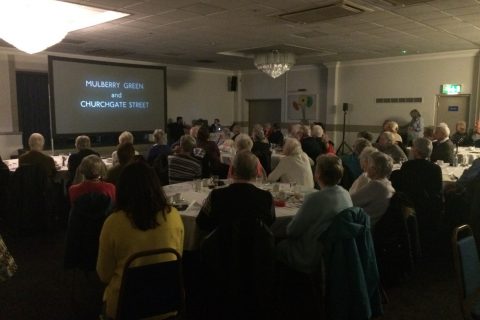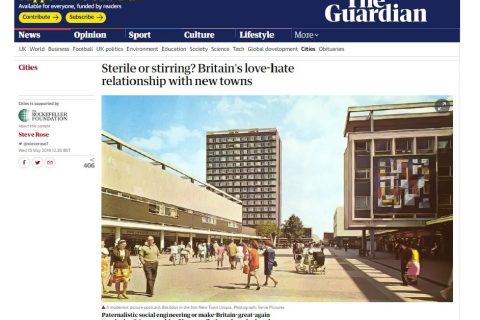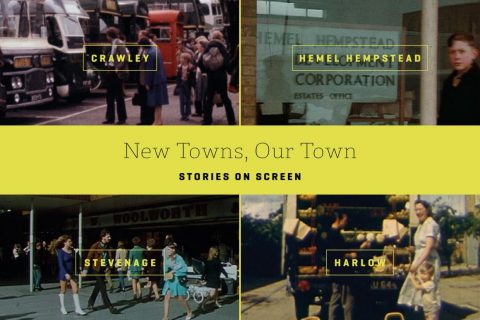With support from the National Lottery Heritage Fund, and working closely with the BFI National Archive, the East Anglian Film Archive and Screen Archive South East, this project sought to increase the visibility of the New Towns movement and to celebrate the unique social history and heritage of these pioneering towns.
Film Hubs
Impact Areas
Focus Areas
Summary
The New Towns movement is one of the South East’s most significant shared stories, with a legacy and an impact that are still felt and discussed today. In the 73 years since the first New Towns Act was passed by the post-war government, the towns it created have been both praised as modern-day utopias and dismissed as failed social experiments.
In developing our Film Hub South East activities, we decided to take a strategic approach to our screen heritage work. We focused on New Towns not only because of their prominence in our Hub region, but because of their lack of provision for access to cultural cinema. Furthermore, at the time of their development there was considerable interest in, and high aspirations for, the New Town movement. As well as attracting national media attention, the Development Corporations themselves were keen to document their progress, choosing to record much of this on the new medium of film. As a consequence, there exists a large collection of archive footage of the New Towns which in itself is unique in capturing the development of the UK’s built heritage – tracing a settlement from its origins through to the present day – but is rarely seen by the Towns’ residents. ‘New Towns, Our Town – Stories on Screen’ sought to dramatically increase access to this material, allowing residents to reclaim, celebrate and contribute to this heritage.
Project aims
To make this valuable archive film more accessible in the UK's first four New Towns (Crawley, Harlow, Hemel Hempstead & Stevenage) and beyond, increasing the visibility of the New Town movement and celebrating the unique social history and heritage of these pioneering towns.
A carefully-planned and varied range of Project activities would enable people to learn about this heritage in different ways, reaching the widest and most diverse number of participants as possible, including those that don’t usually engage with archive film.
Education Resources would enable, encourage and increase the use of archive film in the classroom, with younger people able to demonstrate what they have learnt through the film material and the impact this has had on their understanding of their local heritage.
Through a bespoke and significant training offer, volunteers would learn new and valuable skills in utilising archive film in heritage projects, encouraging future use of the material and building confidence in these individuals to be involved in that legacy.
Oral History Interviews reveal more contextual and valuable information about the films themselves, with the interviews then being available to the public via local cultural/learning venues who can use them to enhance ongoing/future exhibits or other engagement activities.
Headlines
For two weeks in December 2018 we continuously back-projected the footage onto empty shop windows in Harlow’s main shopping centre, and on Stevenage Borough Council windows facing the town’s busy bus station. In Hemel Hempstead we were given exclusive access to screen the footage on their town’s ‘Big Screen’ and in Stevenage and Crawley we also had one-day events in their town squares. Town footfall counters indicated that this activity reached over 150,000 people, maximising the visibility of this heritage and increasing awareness of it.
Our community screenings, taking place between January – March 2019 in a range of spaces including museums, galleries, churches, community centres and care homes across the towns, were attended by over 1000 people (target 720) across 29 screenings, with an average audience of 38 people. 97% of these audiences thought the films were good or very good, and 92% said they would return for a similar event.
We recorded 40 oral history interviews with local residents, using the archive footage as a trigger for memories, stories and valuable information that further contextualises the archive films and expands on current records. We were also able to deposit these recording with local cultural institutions as a permanent, publicly-accessible learning resource, and validating contributors’ stories as valuable and important social documents.
39% of our volunteers were aged between 16-30. Having received bespoke training in how to utilise archive film effectively with audiences, our team of 31 volunteers were key to the project’s success, independently leading screenings and recording oral history testimonies.
The structure of the Project enabled a wide age range of participants to engage with its activities, from an initial focus on older members of the community to school-aged children through the Education Resources, for which we commissioned a bespoke animation featuring archive and contemporary imagery (https://bit.ly/2JnZOKd).
The work generated wide interest, going beyond the original scope of the project. E.g. examined and presented in PhD research (11.5.19 - https://bit.ly/2zBFZsg) ; town planning events/symposiums (24.5.19 - https://bit.ly/2JmgLVj); ); and in The Guardian (15.5.19 - https://bit.ly/2Q4ViAO). We feel this project has clearly demonstrated the value and potential use of archive film beyond the film exhibition sector.
Films
Over the course of the project we worked with the BFI National Archive, the East Anglian Film Archive and Screen Archive South East to source 36 films that were used in eight bespoke packages (one for each town installation, one for each town’s community screenings) and one feature length compilation programme about the New Towns movement.
Films in this compilation programme included: Crawley Events (1928 - 1937); Planned Town (1949); An Experiment in Towns (1958); Postscript to Empire: Britain in Transition (1962); A Home of Your Own (1951); Transatlantic Teleview: New Towns in Britain (1956); Hemel Homestead (1957); Views of Hatfield (1952); Stevenage the First New Town (1977); Basildon Our Town (1974); Peterborough - A City Fit to Live (1971); Milton Keynes - A Village City (1973); Changing Places: Nearly New Town (1982).
Key partnerships
As our organisation is not based in the Project Towns, we had to undertake a lot of consultation to develop our Project Plan and ensure we delivered a relevant and valuable range of activities that would secure buy-in from community organisations across the towns. The project rested largely on the relationships we had built up with key contacts at local authorities and cultural organisations in the Project Towns, both for shaping the activities and promoting them. Invaluable support from our archive partners (BFI, EAFA and SASE) allowed us to access and utilise a wide range of material.
Budget in brief
Total Overall Budget: £102,560. Key Income Sources: BFI FAN Film Hub South East and The National Lottery Heritage Fund. Subsidy per head for Project Beneficiaries/Audiences (approx. 155,050): £0.66. BFI FAN Subsidy per head for Project Beneficiaries/Audiences (approx. 155,050): £0.21.
What worked
We were delighted to be able to work so closely with our archive partners, in particular the East Anglian Film Archive and Screen Archive South East. The selected films and the curation of them worked very well. Our evaluation showed that they were received very favourably by audiences who thoroughly engaged with them.
We spent a significant amount of time developing the project, working on our application to the National Lottery Heritage Fund for over 6 months before submitting. As a result, when the project began we had all partners in place, with expectations and responsibilities clear on both sides. The partners were extremely generous with in-kind support, and we received a positive response from individuals and organisations across the towns.
The New Town movement is a key chapter in the UK’s social history but yet it is often overlooked. A major ambition of this project is to bring more attention to the experiences of the individuals that were part of this movement, and for them to feel proud of this heritage. Giving people an opportunity to reminisce about, and a platform through which to express their lives and experiences helped achieve this goal – and joining up narrative threads across the different New Towns helped create a sense of a unique, shared heritage.
Recruiting volunteers from the Project Towns was one of the Project’s greatest strengths. As well as ensuring we had a range of skills we could utilise effectively (e.g. some were confident public speakers, other had more technical skills), working with local volunteers meant they had significant knowledge of the town and its history that was extremely valuable in achieving the project goals.
What has been difficult
Although an aim of the project was to bring together a shared heritage by working across several towns, there were practical and logistical issues being based centrally (in London) and not in the towns, e.g. moving equipment around towns without easy storage or transportation.
There were a few issues with volunteers dropping out of the project or lacking the skills and confidence to take on certain tasks.
There was a much higher level of community screening requests than anticipated which we were unfortunately unable to fulfill due to lack of staff resources/time.
Delayed recruitment of Project Coordinator created a heavier workload for support staff.
What you would do differently if you did it again
We would plan the project over a longer time period to allow us to accommodate all interest in/requests for Project Activities.
A larger pool of volunteers would have avoided putting strain on particularly committed members of the team.
Due to the wide interest in the project we would have built in more time to explore opportunities presented to us and to take the project further beyond the film exhibition sector.
What audiences said
Best film I’ve seen for a very long time!
An interesting film that will hopefully help people to feel positive about New Towns; the Q&A had very positive participation.
Being very new to Stevenage, these clips have been extremely educational. Food for thought on what the future could feel like based on its history.
Very useful for the young or those without experience of the New Towns… it sparked many memories.
I found it emotional at some points of the film, especially the footage of the young families. It took me back to my younger years.
What professionals, press and partners said
“EAFA was pleased to be invited to participate in the ‘New Towns, Our Town’ project with the Independent Cinema Office. EAFA undertook research into archive film collections and supplied films for the project .The films in our collection were by amateur and professional filmmakers and provide a glimpse into life in the early years of the New Towns. Some of the films had been recently digitised as part of the BFI ‘Britain on Film’ project and the ‘New Towns, Our Town’ project ,through an innovative engagement plan, has ensured that the films have been accessed and enjoyed by new audiences and large audience numbers. We would be very pleased to work with the Independent Cinema Office on future initiatives and have had an excellent working relationship with the ICO throughout the project.”rnrnAngela Graham, Archive Manager, East Anglian Film Archive
“I became involved in this project when I was asked to deliver the training programme for volunteers on using archive film as a reminiscence tool. I have worked in the film archive sector for over 20 years. Archive film can empower people and communities to discover/rediscover individual and communal memory and history. The New Towns project was an excellent example of the best kind of archive film project. The use of the rare footage to illuminate the lives of New Town pioneers and current inhabitants was well thought out, and the legacy of the project will provide useful information. I was delighted to be involved with such a meaningful and important project.”rnrnAngela English, MA PG Cert in Research Practice
“We were first approached to be involved in this project before the submission of the application to the Heritage Lottery Fund which gave us an opportunity to feed into the bid and help identify suitable organisations and partners throughout Crawley. The project worked hard to give the people of the town a sense of ownership over it – from taking the footage into Queens Square, working closely with Crawley Museum, involving local schools and finally providing a preview of ‘New Towns, Our Town’ at the Civic Hall.”rnrnLiz Hart, Arts Development Officer, Crawley Borough Council
“We first met with the ICO about this project in early 2018. We knew then that we would be building toward our own anniversary celebrations of Stevenage Market in December so this was perfect timing for us. I hadn’t seen the archive footage of the town, so to be able to showcase it in the town centre was a great opportunity and generated much positive feedback. We have now licensed the footage directly from the East Anglian Film Archive for an upcoming event, and I am aware other organisations in the town have made similar requests. The ICO team were extremely helpful and passionate in getting this project off the ground. Due to their hard work, volunteer engagement in Stevenage was great, resulting in the great appetite for further access to this material.” Tina Benson, Town Centre Manager, Stevenage Borough Council
“We really enjoyed being involved with the New Towns project as a venue for the film showings and also the oral history interviews. We were impressed by the commitment of the volunteers to the project, and the way in which it helped to build up an archive of local memories, both spoken and visual. The project encouraged people to share their memories and provoked lots of interesting discussions.” Andrea Dumbrell, Learning and Liaison Officer, Crawley Museum
“Harlow Art Trust were delighted to host one of the archive screenings of the Harlow films. We attracted new audiences to the Gibberd Gallery and it was wonderful to capture people's memories around the sculptures that appeared in some of the films. The volunteer team from the ICO that helped with the screening were friendly and well informed and helped make for a smooth running of the event.” Catherine Mummery, Project Co-ordinator, Access Harlow Sculpture Town Project
Press coverage
“A new compilation of archive films from the Independent Cinema Office chronicling Britain’s pioneering post-war New Town movement – and our ongoing love-hate relationship with it” (The Guardian, 15.5.19)
“For decades these films have been kept in various film archives with limited public access. They reveal a fascinating insight into the development of the New Towns, with footage from the 1940s to the present day showcasing how the physical and social landscape of these areas have changed over time” rn(Crawley Observer 9.10.18)
“The Stevenage archive film package uncovers rare footage of the town from the early 1950s until the 1970s. It includes excerpts from a visual tour of the town’s public spaces in 1959 and a 1971 news report featuring the town’s impressive network of cycle paths, walkways, roads and underpasses”. (The Comet, Stevenage , 2.3.19)
“This exciting new project has also enlisted the support of 30 volunteers, highlighting the local pride and community engagement the project has already provided…. Project volunteer Maria Meeham said, “It has been very rewarding to be part of a project bringing archive film back to the communities represented on screen. People have been so generous about sharing their stories and memories and as a result screening events have been great fun.” (Your Harlow, 30.1.19)


